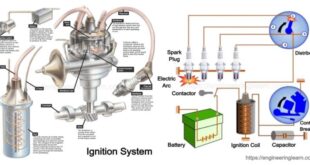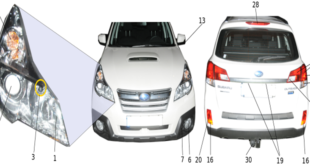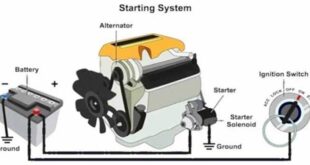There are some substances that are not good conductors. They are not good insulators too. Such substances are called semiconductors. In other words, a semiconductor is halfway between a conductor and a non-conductor. Transistors used in automobile alternator regulators and ignition circuits are prepared using semiconductors.
One example of a semiconductor material is germanium. Silicon also is a semiconductor material. Semi-conductors are of two types; N-type semiconductors and P-type semiconductors.
DIODE
A diode is a device that permits electric current to flow through only one direction, and it will not allow the current to flow in the other direction. Diodes are useful to rectify AC to DC. Alternators in automobiles use the diodes for the rectification of an AC supply
TRANSISTOR
A transistor consists of three alternate sections of N-type and P-type materials. There are two NP- junctions. It may be an NPN transistor or a PNP transistor. The PNP transistor is predominantly used in the central section is called the base which controls the current through the transistor. The section at one end is called the emitter and the section at the other end is called the collector. This depends upon their functioning.
THYRISTORS
A thyristor is usually a semiconductor having three or more junctions. Such a device operates as a switch without any bias. Further, it can be constructed to have voltage ratings of several hundred volts. The family of thyristors consists of PNPN diode (Shockley Diode), SCR, LASCR, TRIAC, DlAC, UJT etc.
The workings of the basic distributor type electronic system is similar to the conventional electrical ignition system, except that in the electronic ignition system a timer is employed in the distributor instead of a contact breaker. This timer may be a pulse generator or a Hall-effect switch or an optical switch that triggers the ignition module and is called the Electronic Ignition Control Unit (E.C.U.). This control unit primarily contains a transistor circuit whose base current is triggered off and on by the timer which results in the stopping and starting of the primary current. Other than this, the electronic ignition system works similarly to the conventional electrical point type system.
DISTRIBUTORLESS IGNITION SYSTEM
In this system, the spark plugs are fired directly from the coils. The spark timing is controlled by an Ignition Control Unit (ICU) and the Engine Control Unit (ECU). The distributor less ignition system may have one coil per cylinder or one coil for each pair of cylinders. Some popular systems use one ignition coil per two cylinders. This type of system is often known as the waste spark distribution method.
This is different than a conventional system firing all plugs in the same direction each time. As additional energy is demanded; the coil design, saturation time, and primary current flow are also different. This redesign of the system allows higher energy to be available from the distributor fewer coils, greater than 40 kilovolts at all rpm ranges. The Direct Ignition System (DIS) uses either a magnetic crankshaft sensor, camshaft position sensor, or both, to determine crankshaft position and engine speed. This signal is sent to the ignition control module or engine control module which then energizes the appropriate coil.
Last word
Due to the sudden discharge of the high voltage energy to the primary winding, a rapid rise in the magnetic flux of the coil takes place, which induces a voltage in excess of 40 VK in the secondary circuit to produce a high-intensity short duration spark.
 NEWSHUNTS
NEWSHUNTS




